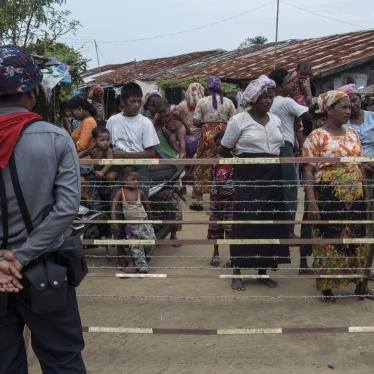The scenes witnessed in the Vanni are devastating: Dead bodies of civilians lie strewn along dusty roads. Hospitals, playgrounds and houses stand ravaged by heavy artillery and rockets fired from multi-barrel launchers. Civilians who remain in the conflict zone come under fire running for cover. Those who manage to flee the fighting lie wounded and dying without adequate medical care in hospital wards or militarized "welfare centres". Loved ones are seen through barbed wired fences but families are kept apart.
This scene of death and destruction is replaying like an unending nightmare in the lives of ordinary Tamil people as fighting between the Sri Lankan armed forces and the Liberation Tigers of Tamil Eelam (LTTE) intensifies in the northern region of the Vanni.
Our latest research shows that up to two thousand civilians have been killed by the Sri Lankan army and the Tamil Tigers since early January in the most recent round of fighting. Both sides have repeatedly violated the rules of war. We got reports of many civilian deaths, which have occurred in areas that the Sri Lankan government has declared to be "safe zones", where the Sri Lankan army has repeatedly and indiscriminately shelled. Hospitals have been frequently hit.
The rebels have refused to allow civilians to flee the fighting, and have fired on those who have sought to make their way to the government side. Many of those remaining under Tamil Tiger control, including children, have been forcibly recruited or forced to do hazardous work on the battlefield. Senior government officials have suggested that Tamils trapped in the war zone can be presumed to be LTTE-supporters and treated as combatants, effectively sanctioning violations.
We interviewed dozens of lucky people who managed to escape the LTTE, only to learn that there are few hopes for them; the Sri Lankan government has inflicted its own atrocities on the ethnic Tamil population. Civilians who make their way to the government “welfare centers” find them no better then heavily militarized detention camps with shockingly poor facilities and no freedom of movement. While the government for security reasons should be screening new arrivals, it is instead secretly subjecting LTTE suspects to arbitrary detention or possible enforced disappearances.
Since the government banned humanitarian agencies and media from the heavy fighting area in the north in September 2008, this war has had few witnesses. The government portrays it as a one-sided, victorious war. With no independent monitors or free media, it has managed to prevent independent public coverage of its military operations and the pitiful condition of civilians trapped in the war. Our two weeks difficult mission on the ground in February revealed that the state machinery is just chillingly mimicking the Tiger's methods of ruthless suppression of criticism..
Till now, the international community has failed to pressure both sides to stop this slaughter of civilians. It is time for concerned governments like Japan, India, and the US to ensure that President Mahinda Rajapakse’s government and the Tamil Tigers allow the victims of this conflict to live with justice and dignity. Both sides should agree to a humanitarian corridor and otherwise respect the laws of war.
If the Sri Lankan government is serious about resolving long-standing Tamil grievances, it should ensure human rights are protected and all those responsible for abuses, are held responsible. Till that happens, it is unlikely that any victory in the battlefield will result in a lasting peace.
Charu Lata Hogg is South Asia Researcher for Human Rights Watch





